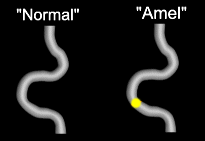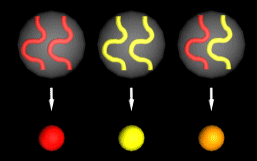|
Genetics Info & Tutorial: Recessive |
 FREE! |
||||||||||||||||||
        |
Remember our “Tyrosinase gene” that helped to produce melanin? Remember how it got mutated and couldn’t help to produce melanin anymore? So if a snake has this “broken” gene, can it produce melanin? The answer is yes, because the snake has two copies. If the other copy still works, this snake will look normal. But, if both copies of this gene are broken, then it will no longer be able to produce melanin. This type of trait is called recessive, because it is controlled entirely by the other, dominant gene, whenever that dominant gene is present. With a recessive trait, both copies of the gene must be the recessive version in order for it to be displayed. Even in the presence of a dominant gene, the recessive gene will still do its thing, it’s just that we won’t be able to see the results in the appearance of the animal.
One other form is called codominant. Below is an example of how codominance can work. Let’s say we have an animal which has only one locus controlling its coloration. Two alleles (different versions of a gene) exist for this locus. One can produce red pigments, and the other can produce yellow pigments. Here’s what such an animal would look like with the different combinations of its genes:
Now, if the normal animals found in the wild were red, and then the yellow mutation were discovered and bred as a morph, the different morphs might be called something like “Normal” reds, “Half yellows,” and “Super Yellow.” The term “super” is often used in herps when a specimen is homozygous for a codominant mutation. Also be aware that codominance can be along a sliding scale with one allele having more dominance than the other. If, in our example, the red pigment is produced in much more abundance than the yellow pigment, then any animal with both genes would then be more reddish than yellowish. Codominance doesn’t mean they are truly equal, it just means that one cannot completely hide the other. A note about the term heterozygous: This term is often misunderstood as meaning “a hidden gene” and is therefore only applied to recessive traits, but this is not the case. It simply means the two corresponding genes are different. Despite the “hidden gene” usage of the term, our orange animal is heterozygous (for red and yellow.) 

|
|
|||||||||||||||||
 All content on this site, unless otherwise noted, is Copyright 2000-2011, Serpentine Widgets. The background, banner, buttons, and footer are original creations by Charles Pritzel+ Privacy Policy | |||||||||||||||||||

